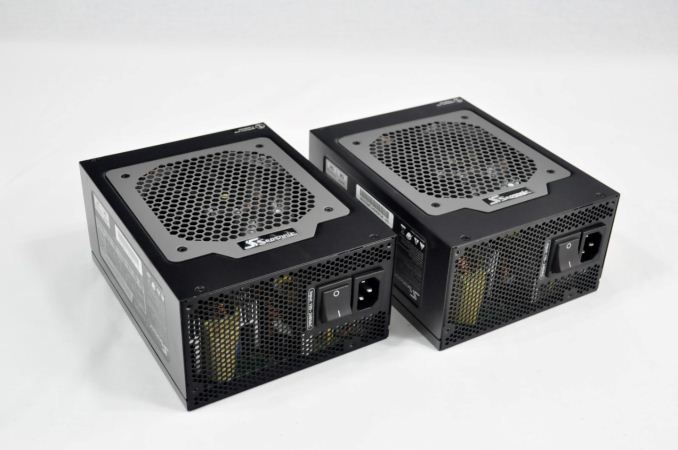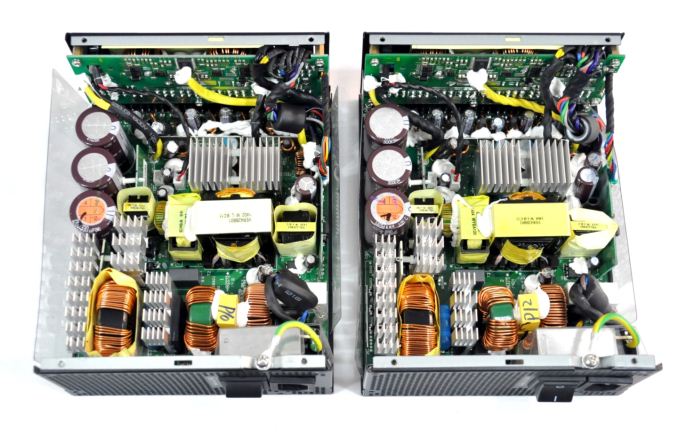Seasonic Platinum SS-1050XP3 & SS-1200XP3 Power Supply Review
by E. Fylladitakis on September 3, 2014 6:00 PM EST- Posted in
- Cases/Cooling/PSUs
- Seasonic
- 1200W
- 80Plus Platinum
- 1050W
External Appearance
Externally, both units are nearly identical, with the sole exception being the sticker with the specifications table on the left side of the chassis. The 190mm long chassis will most likely be too long for small cases, but these units are definitely not designed for compact systems. Seasonic's designs usually are subtle but the company has performed several modifications to enhance the aesthetic value of their top-tier units.
The circular fan guard has been replaced with a rectangular grey panel, with a honeycomb mesh pattern and a badge with the company logo on it. Seasonic added decorative engravings and printed the company and series logos on the right side of the chassis, where they will most likely be invisible, as they will be facing the right side panel of most cases. For these engravings to be visible from a windowed left side panel, the PSU will have to be installed with the fan facing upwards. If the fan is facing downwards, the decorations will also be upside down, so they are best left out of sight. On the left side of the chassis, the side that is visible from windowed side panels, Seasonic placed a sticker with the specifications of the PSU.
A typical C14 receptacle can be seen at the perforated rear side of the units, next to a large on/off switch. The front of the units is filled with connectors for the modular cables and there also is a switch that can change the fan's profile from normal to hybrid mode. The hybrid mode is a quieter thermal profile and allows the fan to be turned off entirely when it's not necessary. Finally, the company and series logos are printed here as well.
Internal Design
Seasonic went with a San Ace 9S1212H403 120mm fan in both of their newest models. It is a very powerful fan, with a top rated speed of 2700RPM. The specifications of the bearing/engine are not available from the manufacturer, but it looks like Sanyo uses a form of self-lubricating sleeve bearing. The life expectancy of this fan is 40,000 hours, a rather mediocre rating for similar devices, but it also translates to about 4.5 years of 24/7 use at 60°C, albeit this rating also is for a free, unobstructed air path (zero static pressure, max airflow).
Seasonic designs and builds their own units so there is no secondary / hidden OEM behind their Platinum series; these PSUs are entirely in-house productions. Both units share the exact same platform and design, with the obvious difference being only the ratings of both the passive and active components. For example, the 1050W version has three Nippon Chemi-Con 330μF capacitors at the PFC stage, whereas the 1200W version has three 390μF capacitors of the same type installed there. Aside from the component ratings however, the two versions do not have a discernible design difference.
The filtering components at the back of the AC receptacle are shielded in an effort to reduce EMI. The total number of filtering components is six Y capacitors, four X capacitors, and three filtering inductors, more than adequate for a strong filtering stage, even for units of this size. Moving towards the APFC stage, we can see the two bridge rectifiers on their own small heatsink, followed by a sizable APFC coil and three capacitors from Nippon Chemi-Con.
The active PFC components are on the long heatsink near the edge of the PCB, while the smaller heatsink towards the center of the unit holds the four transistors that form the full-bridge inversion stage. Two square heatsinks cool the active components of the secondary conversion stage, which are not directly attached to the heatsinks but are on the rear of the PCB. Nippon Chemi-Con supplies all of the secondary side capacitors as well, electrolytic and solid alike, making these units an all-Japanese affair.
When it comes to build quality, Seasonic has an excellent reputation for designing and building top-quality products; these two units however surprised us. Seasonic is definitely using top-tier components, some of the best that can be found in a consumer-grade product. The soldering job is excellent as well and we could not find a single bad joint or weak point. What confounded us however is that the assembly of the Platinum units is rather messy, which is a first for Seasonic.
It is not bad, not even average, but it does not live up to the standards Seasonic themselves have set. There are cables pressing against components and many electrolytic capacitors appear to have received mechanical force after they have been soldered on the board, tilting them left and right. Even the glue appears to have been spilt carelessly and purposelessly, as there are spots where it does not even touch the components it is supposed to. If this was true for just one sample, we could consider the possibility of it being an "isolated case", but both of the samples that we received share these flaws, so it is not random. Perhaps these are just pre-production or early samples, and we hope so, but we've seen better attention to detail in previous Seasonic units.

























39 Comments
View All Comments
Impulses - Thursday, September 4, 2014 - link
I'm not sure I buy that NV and AMD are putting efficiency at the forefront, seems it's kinda cyclical for each ands then they regress.Case in point, I recently had to buy a new PSU because the 750W that could easily handle two AMD HD6950 in CFa couple years ago wouldn't be enough for two new R9 290. Ended up with a Seasonic X-1250 just because it was on sale (was looking at 1K units otherwise).
Seasonic's biggest competition seems to be themselves (they now have three top end lines? the Gold X models and two Platinum lines?) and the various brands that resell Seasonic designs (XFX etc).
romrunning - Thursday, September 4, 2014 - link
I'm curious - how much power does your system actually draw?A link here (http://www.anandtech.com/show/8422/amd-announces-r... said the R9 290 draws 250W. Even if they spike to 275-300W under heavy load, you still have 150W for everything else. Are you running a 220W AMD CPU or something?
Impulses - Friday, September 5, 2014 - link
I could maybe get away with the 750W unit, but I wasn't really looking forward to running it at 100% load thru hours of gaming, and/or unexpected crashes while OC'ing etc.DanNeely - Thursday, September 4, 2014 - link
There's something wrong with the -12V column in the table. 3A @ -12V would be 36 watts of power not 6. 3A also seems unusually high for a current generation model.E.Fyll - Thursday, September 4, 2014 - link
Thank you for pointing that out Dan. The 5VSB and -12V columns were reversed, that was a typo mistake on my part.WilbertCane29 - Friday, September 5, 2014 - link
I found this to be really interesting. Are there any more sources on this? I would like to know more about this.Oxford Guy - Wednesday, December 3, 2014 - link
Typical review site doublespeak:The power supply can be "ear splitting" and "be heard from rooms away" but:
"we do believe that very few users actually require their system to remain silent while it is heavily loaded."
Give me a freakin' break. 50+ db is related to a desire for silence how, exactly? Not having something cause someone to develop tinnitus during the warranty period has to do with a quest for silence how, exactly?
"it is known that such powerful units have a very limited target audience."
Yes, the deaf.
Oxford Guy - Wednesday, December 3, 2014 - link
It's long past time for these antique standards like ATX with 120mm fans be replaced. If you're going to provide 1000 watts of power or more, move to a new form factor. How about a 200mm fan with a vapor chamber?Think outside of the bloody box! And, stop apologizing for these poor thoughtless designs. This power supply is unsuitable for use out side of a server room.
Oxford Guy - Wednesday, December 3, 2014 - link
It pisses me off to no end to see the same regurgitation of anachronism year after year, with the most miniscule changes being hailed as great innovation. Why can't companies actually innovate?Make the entire top of a PC case a triple width 360mm radiator instead of these absurd tower designs with redundant narrow radiators and fans splattered all over the place, competing with each other. Link in the GPUs, the CPU, the motherboard VRMs, and the power supply with heat pipes and a giant vapor chamber. Do something instead of this piecemeal and pathetic series of attempts to shoehorn high wattage equipment into form factors that don't work.
I remember when Apple told people to drop their Apple IIIs onto desks to reseat the chips that popped out from heat — because Apple designed the case to be oh-so-pretty before it finished engineering the internals! This is the same nonsensical mentality that dominates the "enthusiast" equipment industry and review sites' appraisals. The assumption is that the form factors already exist and must be slavishly followed, no matter how idiotic the result.
But, while I sit around unemployed in disgust in the midst of cornfields I get to see the parade of banality continue...
I realize that Silverstone has done a bit with its triple and dual 180mm fan rotated designs but those are not adequate for really quiet computing with high wattage multiple GPU machines. People even suggest pairing blower GPUs with those cases. Blower GPUs! Blowers on GPUs should have been consigned to the relic bin 10 years ago. Sure... let's pair a high wattage part with a teeny tiny little fan and form factor. Then, let's put two or three into the system to double or triple the stupidity. That makes sense!
Linked heat pipes, linked radiators, big vapor chambers, single air path, the case acting as a heat sink as well... Centralized non-redundant non-competitive cooling mechanisms. That is the future, not more of the same 50+ db just for the power supply BS, teeny tiny fans, 5 or 6 airflow paths in different directions, and general anachronistic chaos disguised as cleverness.
I know it makes more money for manufacturers to keep people in the upgrade mouse wheel, trying to get a decent product by cobbling together all the half-hearted efforts but it's time to start delivering a holistic well-made product without paying Mac Pro prices or worrying about Apple's obsession with glamour.
Get with it, people.